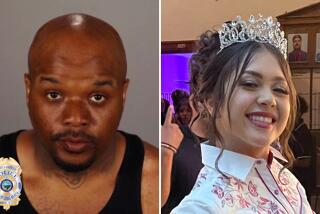Elliot Rodger, a quiet, troubled loner, plotted rampage for months
Elliot Rodger planned his deadly rampage in Isla Vista for nearly two years, stockpiling guns and ammunition and visiting local target ranges.
He did Internet research on Nazis, terrorists and how to kill people silently. He made videos threatening to kill women, particularly sorority members, over perceived slights.
He obsessed over designer clothes and began playing the lottery, even driving to Arizona to buy Powerball tickets because the game wasn’t available in California. He wrote about what he would do with his winnings.
“I will be able to fully indulge in everything I’m passionate about: exotic cars, luxurious mansions, expensive clothes, and of course, sex with beautiful girls,” he wrote. “They will finally see me as the supreme man that I’m meant to be.”
This was the portrait of a killer that emerged from a nine-month investigation by the Santa Barbara County Sheriff’s Department into the May 23, 2014, slayings that left six UC Santa Barbara students and Rodger dead and ignited renewed calls for national gun control measures.
The long-awaited study portrays Rodger, 22, as lonely and troubled. Investigators said he appeared to have no friends at Santa Barbara City College, where he was a student, and seethed about women and his own virginity. It also cataloged in graphic detail his rampage, which included stabbing his roommates’ friend 94 times.
Although Rodger had several interactions with the Sheriff’s Department before the rampage, the report found that deputies had no reason to put him on a mental health hold or conduct further investigation.
“There was nothing during the contact with [Rodger] that gave the deputies reason to believe he was a danger to himself or others,” the report stated. “Such risk factors are required in order to place someone on an involuntary mental health hold, or to legally search their residence.”
From an early age, Rodger struggled with social interactions and displayed anxious behavior, according to the report. In elementary school, he rarely engaged in conversation, frequently whispering when spoken to, preferring to write his answers on paper. He spent his recesses hiding behind a building instead of playing with other children. He was uneasy at birthday parties. During one trip to Disneyland — when he was about 5 or 6 years old — Rodger cried because there were “too many people.”
The report noted that although Rodger saw counselors and received medication to treat the behavior, there was “no history of aggression while growing up.”
As he got older, however, that changed. He grew angry toward women, who he felt had unjustly rejected him. Rodger became convinced that the only way to get a girlfriend was to become wealthy.
The report said Rodger had postponed his deadly rampage at least once because he was concerned that too many police would be around. Deputies said Rodger started preparing for the attack in December 2012. He spent nearly $2,500 between December 2012 and March 2013, purchasing guns and ammunition from stores in Burbank, Goleta and Los Angeles.
In February 2014, Rodger began visiting gun ranges. He made two separate ammunition purchases in March and visited two gun ranges in April, a month before the shooting.
“This activity indicates the suspect was ‘ramping up’ in the planning and rehearsing stages prior to committing the crimes on May 23, 2014” the report said.
The report broke down Rodger’s murder rampage into 17 separate incidents, starting with killing his two roommates, Weihan “David” Wang, 20, and Cheng Yuan “James” Hong, 20. They were ambushed separately as they entered the apartment, stabbed to death and left in their bedroom.
Rodger then killed their friend, George Chen, 19, and left his body in the bathroom. Chen was stabbed 94 times, Wang 15 and Hong 25. Hong, who was still wearing his backpack, had apparently tried to defend himself because he had cuts to his hands and arms. Five of Hong’s back wounds were “postmortem injuries,” the report states.
Deputies said Rodger’s bed and pillows had slashes and stabs in them, indicating that Rodger “may have been practicing his stabbing/slashing movements in order to rehearse and prepare himself for the attacks against his victims.”
There was a three-hour gap between the stabbings and the start of the shootings. During that time, Rodger changed out of his bloodstained shirt and pants, went to Starbucks, where he bought a triple-vanilla latte, sent his manifesto to his parents and uploaded his “Retribution” video to YouTube, both outlining his deadly plans.
The shooting rampage lasted eight minutes and left three people dead and 14 others wounded, including a sheriff’s deputy. Authorities said he hit seven people with his car and shot at pedestrians as he drove through town, firing at least 55 rounds.
At one point, he stopped next to a woman who was walking and asked, “Hey, what’s up?”
When she answered, he smiled, showed her his handgun, then fired at her. The bullet whizzed past her face.
“The suspect continued to smile as he fired the pistol,” the report states. The woman got away without being hit.
Rodger targeted a sorority house and shot three young women. Two of them, Veronika Weiss, 19, and Katie Cooper, 22, were killed. He opened fire on customers inside a local market and fatally wounded Christopher Michaels-Martinez, 20, the last victim to die at Rodger’s hands.
Rodger shot himself inside his car after exchanging gunfire with deputies. He had three guns.
It was too late by the time his family and Santa Barbara County investigators had connected his videos and manifesto to the bloodshed occurring in Isla Vista.
When deputies identified Rodger as the gunman, they called his parents. They were already rushing to his home because of the disturbing manifesto he emailed to them. They were unaware of the violence he had inflicted.
About three hours after the shooting, deputies raided his apartment. In his room, they found the laptop on his bed “flipped open and turned on, displaying a YouTube page acknowledging that a video had just been uploaded. A screen shot from the suspect’s ‘Retribution’ video was visible on this YouTube page.”
Next to the manifesto, authorities found his journal. The final entry was made on the day of the shooting: “I had to tear some pages out because I feared my intentions would be discovered. I taped them back together as fast as I could. This is it. In one hour I will have my revenge on this cruel world. I HATE YOU ALLLL! DIE.”
Times staff writer Richard Winton contributed to this report.
More to Read
Sign up for Essential California
The most important California stories and recommendations in your inbox every morning.
You may occasionally receive promotional content from the Los Angeles Times.













